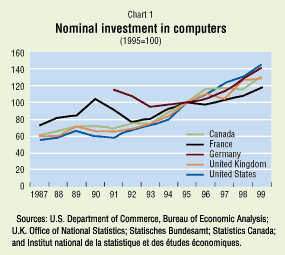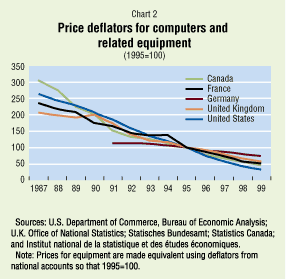 About F&D Subscribe Back Issues Write Us Copyright Information United States and the IMF |
Who Has a New Economy? Paula De Masi, Marcello Estevão, and Laura Kodres In the second half of the 1990s, the United States enjoyed strong economic growth combined with low inflation and increased labor productivity, leading many observers to proclaim the birth of a "new economy" linked to advances in information and communications technologies. The United States has been a leader in both producing and investing in information and communications technologies (ICT), so it seems natural that the new economy should have begun there. IMF staff and other economists are conducting research into whether the relationship between ICT and productivity growth extends to other major industrial countries. The evidence so far is mixed. Despite the attention the term "new economy" has received, observers disagree on the extent to which the fundamentals of the U.S. economy have changed—and even on what constitutes the new economy. However, a commonly cited defining characteristic of the new economy is an increase in potential output growth with low inflationary pressures. In this article, we define the new economy as one characterized by higher long-term growth that is due to a permanently higher growth rate in productivity stemming primarily from the production, adoption, and continued diffusion of ICT. With regard to the U.S. experience, evidence suggests that there was a link between ICT and the acceleration in labor productivity growth in the second half of the 1990s. However, it is not yet possible to conclude whether this shift to higher productivity growth is sustainable or whether it represents a onetime transition to a higher level of productivity. Technological innovations can raise labor productivity growth by (1) increasing ICT capital relative to labor in ways that result in more output (capital deepening) and (2) altering the way capital and labor interact (better techniques or organization) so that production is increased although the amount of capital and labor used stays the same—in other words, total factor productivity (TFP) increases. Although these two components of labor productivity growth could, in principle, act independently of one another, with regard to ICT they are interrelated. TFP growth in sectors producing ICT goods leads to steep price declines for ICT-related products. As their prices decline, investment in these products surges; the rate of ICT capital accumulation exceeds that of overall labor input; and ICT capital deepening occurs. Both the rise in TFP growth within the ICT sector and ICT capital deepening boost labor productivity growth. In addition, continuing changes in business behavior that are due to the widespread use of these technologies could be expected to increase TFP growth in other sectors of the economy. Evidence from the United States The rapid adoption of ICT has been widely credited as the driving force behind the acceleration in U.S. labor productivity growth that took place during the 1990s. Technological innovation resulted in sharp declines in computer prices of about 22 percent a year, on average, over 1995-2000 (Chart 1). The price declines encouraged industries to invest in information processing equipment and peripherals; investment surged, in real terms, by an average annual rate of about 44 percent (this real growth rate is obtained by deflating nominal investment by the U.S. national accounts quality-adjusted price index).

To determine the role of ICT in boosting labor productivity growth, several studies have attempted to separate labor productivity growth into capital deepening and total factor productivity growth (see table). (See, for example, Jorgenson and Stiroh, 2000; and Oliner and Sichel, 2000.) These studies found that greater efficiencies in producing computers and semiconductors have boosted TFP—and hence labor productivity—in the ICT sectors, as evidenced by plunging prices for ICT products. Low prices have encouraged other industries to invest more heavily in ICT-related equipment, contributing to capital deepening and further boosting labor productivity growth. Changes related to the production and use of ICT accounted for an estimated two-thirds of the acceleration in labor productivity growth in the second half of the 1990s. Skeptics have argued that these results do not take account of the cyclical component of productivity growth and may be mistaking a cyclical pickup for a trend increase (see Gordon, 2000). Evidence that increases in TFP growth were concentrated in the computer and semiconductor sectors prompted critics to question whether business practices have improved because of the new technology and the Internet or whether employees have just been surfing the web for their own benefit or pleasure. However, more recent evidence has confirmed that the pickup in productivity growth appears to be more than just a cyclical phenomenon. Using data for individual industries, Stiroh (2001) shows that the industries that invested most aggressively in ICT in the early 1990s also posted the largest gains in labor productivity growth. The sharp contrast between productivity growth in ICT-intensive and other industries suggests that the productivity pickup is not just cyclical. Moreover, a 2001 study by the U.S. Council of Economic Advisers finds that there is only a small cyclical component to the acceleration in labor productivity growth and that the acceleration can be attributed to faster capital deepening and a pickup in TFP growth in both the computer and the noncomputer sectors. Evidence from other industrial countries This acceleration of labor productivity growth tied to ICT production and use has been, for the most part, more evident in the United States than in other industrial countries, despite high rates of ICT investment (Chart 2). The reasons for relatively lackluster productivity growth in the second half of the 1990s differ from country to country, suggesting that, despite a global market in ICT goods and services, the results for economies are not uniform and probably depend on structural characteristics that determine how new technologies are absorbed.

Canada. Given Canada's high level of economic integration with the United States and broadly similar economic policies over the last few years, a U.S.-style pickup in labor productivity growth would have been expected to occur sooner there than in other industrial countries. But labor productivity growth has not accelerated in Canada because little capital deepening has occurred and TFP growth has not increased (see Cerisola, De Masi, and Culiuc, forthcoming). Nonetheless, during the 1990s, Canada's ICT sector grew at an average annual rate of about 10 percent. It accounted for about 6 percent of GDP in 1999, up from just 3 percent in the early 1990s. Since the mid-1990s, ICT products have accounted, on average, for about 30 percent a year of total investment spending in Canada, raising the share of ICT in the capital stock to 4 1/2 percent. An examination of the relationship between ICT and labor productivity growth reveals that ICT capital deepening accounted for about 0.3 percent growth in labor productivity in the second half of the 1990s, even though capital deepening in the aggregate contributed zero. Two other factors explain why Canadian productivity growth has lagged behind that in the United States. First, the ICT sector is much smaller, relative to the manufacturing sector, in Canada than in the United States, so that even if the two countries experienced the same acceleration in TFP growth, manufacturing productivity would still grow more slowly in Canada than in the United States. Second, Canadian firms have tended to lag behind multinationals operating in Canada in adopting new technologies. The evidence suggests, however, that it is primarily small and medium-sized Canadian firms that have fallen behind; large Canadian firms seem to be as eager to acquire new technologies as the multinationals. From a broader perspective, cyclical and structural factors explain why Canada has not seen an acceleration in productivity growth. The 1990-91 recession was much more severe and prolonged in Canada than in the United States, and Canada's recovery was significantly slower; investment in machinery and equipment was particularly weak through 1996, but has recovered since then. Several important structural changes—most notably, the North American Free Trade Agreement and deregulation in Canada's telecommunications, transportation, and financial sectors—have led to corporate restructuring in Canada that may have been partly responsible for the slow growth of labor productivity, reflecting lags between restructuring and efficiency gains. United Kingdom. Surprisingly, labor productivity growth has not accelerated in the United Kingdom, where the rate of investment in ICT is almost as high as it is in the United States. Adding to the puzzle is the fact that, like the United States, the United Kingdom has flexible labor markets and relatively competitive product markets. Recent research on the United Kingdom suggests a link between ICT investment and production and labor productivity growth, as in the United States. In terms of labor productivity, IMF calculations show that the contribution of ICT capital deepening to labor productivity growth amounted to about 1/2 of 1 percent during the late 1990s, compared with about 1 percent for the United States. When remaining TFP growth is broken down into the parts attributable to the ICT-producing sector and to the rest of the economy, there is little difference between the productivity of the two countries' ICT sectors. Using U.S. deflators for ICT equipment, average TFP growth in the United Kingdom and the United States' ICT sectors during 1997-98 was, respectively, 15 percent and 17 percent a year. (These estimates exclude the highly productive semiconductor industry, which is very small in the United Kingdom.) Although the estimated contribution of ICT to labor productivity growth in the United Kingdom is not far below that in the United States, and capital deepening in the two countries is comparable, overall productivity growth in the United Kingdom slowed in the late 1990s; the slowdown is even greater when the ICT sector is deducted. The reasons for this are not obvious, but many commentators have pointed to the lower intermediate and vocational skill levels of U.K. workers compared with workers in other industrial countries and less research and development by U.K. firms. France. In contrast to the United Kingdom, where labor productivity growth slowed because of weaker TFP growth, lower labor productivity growth in France in the second half of the 1990s is attributable mostly to a decline in overall capital deepening on the heels of continued moderation in labor costs (Estevão and Levy, 2000). This decline reflects waning investment in labor-saving technologies—investment that increased in the 1980s in response to the escalation of labor costs in the mid-1970s. Actually, TFP growth rebounded in the second half of the 1990s as the economy recovered, even though it remained below the growth rate attained in the 1980s. However, the increase does not appear to be influenced heavily by France's ICT-producing sector, which is still quite small, and should probably be attributed to cyclical factors. The deceleration of capital deepening evident in the French economy as a whole does not, however, extend to ICT capital. Real investment in computers and peripherals, for instance, has grown nearly 30 percent a year in recent years. Such strong growth is reflected in an increase in the contribution of ICT capital deepening to labor productivity growth in the nonfarm, nonfinancial business sector from nearly 0 to 0.2 percent. Thanks to continuing strong investment in ICT, the contribution of ICT capital deepening to labor productivity growth is likely to rise significantly in the next few years. Also, the rapid expansion of high-tech businesses (notably services based on mobile-phone telecommunications and the Internet), which have grown in France as fast as in most other European countries, is expected to increase business efficiency. Germany. Nor did productivity growth pick up in Germany in the late 1990s—in fact, it slowed—making it hard to see any evidence of a link between ICT investment and productivity. Although, in principle, a more disaggregated examination may show that Germany's ICT sector is different, such an analysis is hindered by a lack of data. Nevertheless, some "back-of-the-envelope" calculations suggest that Germany may not be as far behind the United States as was previously thought. Because the impact on labor productivity growth is due to price declines for ICT products that induce firms to increase their ICT capital stock, researchers have focused on this. The price deflators used in the German national accounts do not show the large declines evident in the United States, in part because they do not fully take account of improvements in the quality of computers. However, when U.S. price deflators are applied to German nominal investment in electronic data processing equipment (such as office machines), this spending category is shown to have grown at an average annual rate of 27.5 percent during 1992-99, rather than at the 6 percent yearly rate obtained when a conventional price deflator is used (Deutsche Bundesbank, 2000). In the United States, the spending category grew by about 40 percent a year during the same period. A mixed picture Although studies have shown a link between high investment rates in information technologies and improved productivity performance in the United States, in other countries the picture is mixed. Even using quality-adjusted price deflators that show robust ICT investment, the measured effects on productivity growth in both France and Germany have been relatively small, mainly for three reasons. First, the recoveries in both France and Germany, after the recession of the early 1990s, were labor intensive—employing relatively low productivity labor first, and thus lowering overall productivity. Second, the ICT sector accounts for a smaller share of the French and German economies than of the U.S. economy, so that ICT productivity growth has less influence on those countries' overall economies. Third, the growth rates of ICT investment in the two countries climbed into the double digits later than in the United States, so it is not too surprising that measured effects of ICT on labor productivity growth lag behind those of the United States. Canada's slow productivity growth can be traced to the smaller size of its ICT sector as well as to differences in the pattern of ICT adoption. In the United Kingdom, slow economy-wide productivity growth seems to be masking the growth associated with strong rates of investment in information technology. Looking ahead, further development of the ICT sector will depend on a variety of factors that support both technological innovation and the adoption of new technologies. In continental Europe, the sluggish growth of labor productivity raises questions about the labor and product markets, whereas the dynamism of these markets in the United States is believed by many to be the critical factor that has allowed U.S. companies to move quickly to take advantage of new technologies. Thus, for Europe, continued deregulation of labor and product markets, flexible work and compensation practices, and further development of financial markets will be important in creating technology-friendly conditions. In the United States, the sustainability of the observed acceleration in labor productivity growth will depend on continued technological innovation—in particular with regard to semiconductors—further declines in technology prices, and continued adoption and diffusion of ICT. In the recent past, rapid technological innovation in the United States reflected a confluence of factors, including strong competition that fueled the need for cost-saving technology, robust public and private spending on research and development, strong intellectual property protection, and access to ample financing—many of which appear to be firmly in place and bode well for future technological breakthroughs. However, the dramatic drop in the NASDAQ—particularly since the fall of 2000—suggests that venture capital and the prospects for initial public offerings are likely to be dampened, at least in the near term, thus limiting financing opportunities. So who has a new economy? Measured against the criterion we established at the beginning of this article—a permanently higher labor productivity growth rate linked to innovation and diffusion of ICT goods and services—no economy examined in this article qualifies as yet. However, the current slowdown in the United States should provide a valuable test of the durability of U.S. productivity gains.
References:
|
||||||||||||||||||||||||||||||||||||||||||||||||||||||||||||||||||||||||||||||||||||||||||||||||||||||||||||||||||||||||||||||||||||||||||||||||